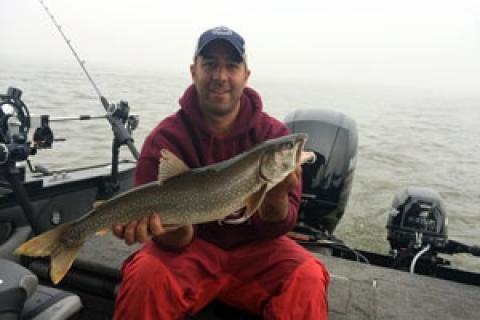
 When many people think of fishing for lake trout, they think of the gear needed, including downriggers, and this discourages many anglers. Although downriggers are a very valuable when targeting these fish, there are times of the year when Lakers come up shallow, making them easy to target.
When many people think of fishing for lake trout, they think of the gear needed, including downriggers, and this discourages many anglers. Although downriggers are a very valuable when targeting these fish, there are times of the year when Lakers come up shallow, making them easy to target.
One of the simplest and best ways to target shallow lake trout is flat line fishing. When the water is cold enough on the surface and along shorelines, such as in the spring, lake trout will feed on the surface and close to land. This pattern of behavior allows anglers to target these fish with conventional tackle and lures. Because of the shallow depth that these fish stage at, using a flat lining technique to present baits to fish can be very productive.
So What is Flat Line Fishing?
Flat lining is a simple practice of trolling along the shoreline and letting out a fishing line behind the boat with a floating/shallow running lure. With some simple tools like planer boards, anglers can flat line several lines at once behind the boat covering large amounts of water.
What Do You Need to Line Fish?
If you don't have the tackle already, then trolling rods with line counters are the way to go. If you already have gear, then spinning or casting rods can be used.
Try to pick longer rods with heavier backbones and soft tips, as they seem to be best for this type of fishing. If you plan on using your regular tackle, just make sure that you are spooled with at least 20-pound test. Big lake trout can put up a great fight when hooked, and light lines won't hold up.
If you plan on fishing multiple people out of the same boat, then purchasing planer boards is a must. Planer boards will pull your fishing lines away from the boat, allowing anglers to fish multiple lines at the same time without getting tangled. Quality snaps and swivels are another vital piece of tackle for flat lining as trolling baits can really twist lines causing tangles.
What Speed Should You Troll?
Trolling speed for flat lining can vary a lot from 1.3 to 3-plus mph. Start out slower 1.5 to 1.8 mph and work your way faster if the fish are not responding. Running at 2 to 2.5 seems to be the standard for flat lining Lakers in the spring, but again depending on the wind, current and the fishing pressure, the speed may vary day to day.
One important point to remember is that trolling with the current and into the current are not always equal just because you are holding the same speed. Trolling into the current will have baits working very hard and trolling with the current will impart less action on lures. You might have to adjust your speed up or down depending on the current to keep baits running the way you want.
What Fishing Lures Should You Use?
Lure selection is probably the hardest point to cover with flat lining for Lakers. Trolling baits come in almost every color, size and depth combination imaginable. Stick baits in the 4- to 7-inch range seem to be the norm and anglers should always try and match the natural forage fish that are present in their respected bodies of water.
There is something to be said about having some hot colored lures for trolling in your collection. It seems every year that one fluorescent red or green bait seems to get the fishes attention more than the other. If you don't know where to start with colors, then asking at your local bait shop what has been working is a good idea.
Depth of lures is a very critical point to get right. If you are planning on fishing 10 feet of water, then your baits can't be deep diving models that go to 12 feet. You should have a few baits that cover the most common depths that you plan on fishing (baits for 2-5 feet, 4-8 feet and 5-12 feet of water).
With a little planning, some simple gear and luck, finding lake trout in early season can be exciting and well worth the effort.
- 28178 views

